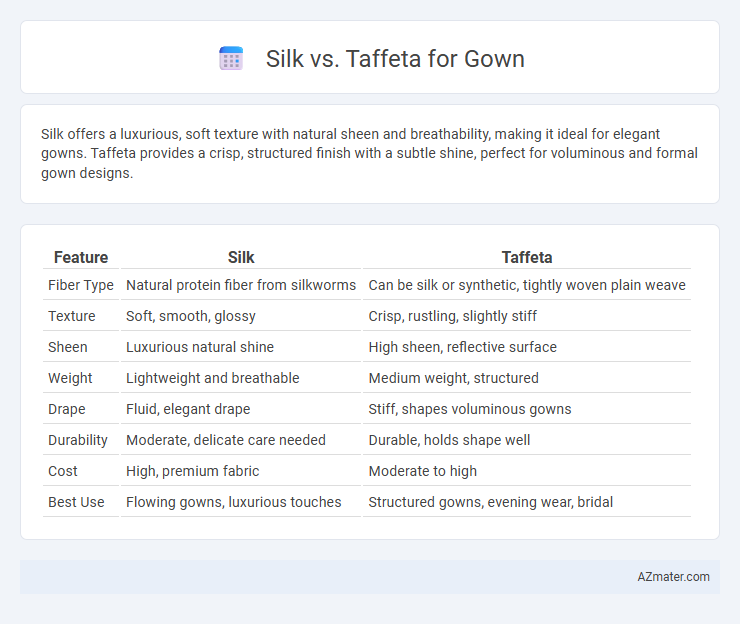Silk offers a luxurious, soft texture with natural sheen and breathability, making it ideal for elegant gowns. Taffeta provides a crisp, structured finish with a subtle shine, perfect for voluminous and formal gown designs.
Table of Comparison
| Feature | Silk | Taffeta |
|---|---|---|
| Fiber Type | Natural protein fiber from silkworms | Can be silk or synthetic, tightly woven plain weave |
| Texture | Soft, smooth, glossy | Crisp, rustling, slightly stiff |
| Sheen | Luxurious natural shine | High sheen, reflective surface |
| Weight | Lightweight and breathable | Medium weight, structured |
| Drape | Fluid, elegant drape | Stiff, shapes voluminous gowns |
| Durability | Moderate, delicate care needed | Durable, holds shape well |
| Cost | High, premium fabric | Moderate to high |
| Best Use | Flowing gowns, luxurious touches | Structured gowns, evening wear, bridal |
Introduction: Silk vs Taffeta for Gowns
Silk and taffeta are two popular fabrics commonly used in gown construction, each offering distinct textures and finishes. Silk provides a smooth, luxurious feel with natural sheen and excellent drapability, making it ideal for elegant, flowing gowns. Taffeta, characterized by its crisp texture and slight rustling sound, offers structure and volume, perfect for gowns requiring a more dramatic silhouette.
What is Silk? Key Features and Benefits
Silk is a natural protein fiber produced by silkworms, known for its smooth texture, luxurious sheen, and excellent breathability. Key features include its lightweight drape, hypoallergenic properties, and ability to regulate temperature, making it comfortable for gowns in various climates. Benefits of silk gowns include a soft, elegant look, durability when properly cared for, and natural moisture-wicking that keeps the wearer cool and dry.
What is Taffeta? Key Features and Benefits
Taffeta is a crisp, smooth woven fabric made from silk or synthetic fibers, known for its lustrous sheen and rustling sound. Key features include its lightweight structure, excellent drape, and ability to hold shape, making it ideal for structured gowns and formal wear. Benefits of taffeta gowns include their elegant appearance, resistance to wrinkles, and durability, providing a polished and long-lasting look for special occasions.
Texture and Feel: Comparing Silk and Taffeta
Silk offers a smooth, luxurious texture with a natural sheen that feels soft and breathable on the skin, making it ideal for gowns requiring elegance and comfort. Taffeta, characterized by its crisp, structured texture and slight rustling sound, provides a more voluminous and dramatic silhouette but can feel stiffer compared to silk. The choice between silk and taffeta hinges on the desired gown feel: silk for fluidity and softness, taffeta for body and architectural shape.
Appearance and Sheen: Aesthetic Differences
Silk offers a natural, luxurious sheen that catches light softly, creating an elegant and fluid appearance ideal for gowns seeking a classic, graceful look. Taffeta features a crisp texture with a lustrous, reflective surface that produces a vibrant, structured shine, giving gowns a more dramatic and sculpted aesthetic. The subtle, smooth shine of silk contrasts with taffeta's bright, glass-like luster, influencing gown choices based on the desired visual impact and formality.
Weight and Drape: How Each Fabric Falls
Silk offers a lightweight, fluid drape that creates a soft, elegant silhouette, ideal for gowns requiring gentle movement and natural flow. Taffeta, being heavier and stiffer, holds shape well with a crisp, structured fall that adds volume and dramatic flair to formal dresses. The contrast between silk's supple fall and taffeta's firm body influences gown design, fit, and overall aesthetic.
Comfort and Breathability: Which Feels Better?
Silk offers exceptional comfort due to its natural fibers, providing a smooth texture that feels light and breathable against the skin, making it ideal for long-wear gowns. Taffeta, often made from silk or synthetic fibers, tends to be stiffer with less breathability, which can lead to a less comfortable experience in warm conditions. For gowns prioritizing comfort and breathability, silk generally outperforms taffeta by delivering a cooler and softer feel.
Durability and Maintenance: Caring for Silk vs Taffeta
Silk gowns require delicate care, often needing dry cleaning to preserve their natural fibers and avoid damage from water or harsh detergents, while taffeta, made from silk or synthetic fibers, tends to be more durable and resistant to wrinkles and stains, allowing for occasional hand washing or gentle machine cycles. The durability of taffeta makes it a practical choice for gowns subjected to frequent wear or needing a crisp, structured look, as it retains shape well and withstands abrasions better than silk. Proper storage in a cool, dry place with minimal exposure to sunlight extends the lifespan of both fabrics, but silk demands more cautious handling to prevent snags and discoloration.
Cost and Accessibility: Budget Considerations
Silk gowns typically come with a higher price tag due to the labor-intensive production process and the quality of natural fibers, making them less accessible for budget-conscious buyers. Taffeta, often made from synthetic fibers or blends, offers a more affordable alternative while still providing a luxurious sheen and crisp texture ideal for gowns. When budgeting for gowns, choosing taffeta allows for cost savings without significantly compromising on elegance and style.
Best Uses: Choosing the Right Fabric for Your Gown
Silk offers a luxurious sheen and smooth texture, making it ideal for elegant evening gowns and bridal wear that require fluid drape and comfort. Taffeta, with its crisp, structured feel and slight sheen, is best suited for ball gowns, formal dresses, and designs needing volume and body. Selecting between silk and taffeta depends on whether a soft, flowing silhouette or a structured shape is desired for the gown's design.

Infographic: Silk vs Taffeta for Gown
 azmater.com
azmater.com